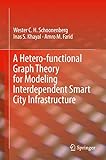A Hetero-functional Graph Theory for Modeling Interdependent Smart City Infrastructure [electronic resource] / by Wester C. H. Schoonenberg, Inas S. Khayal, Amro M. Farid.
By: Schoonenberg, Wester C. H [author.] .
.
Contributor(s): Khayal, Inas S [author.] | Farid, Amro M [author.]
| Farid, Amro M [author.] | SpringerLink (Online service)
| SpringerLink (Online service) .
.
Material type:  BookPublisher: Cham : Springer International Publishing : Imprint: Springer, 2019Edition: 1st ed. 2019.Description: XXX, 196 p. 93 illus., 79 illus. in color. online resource.Content type: text Media type: computer Carrier type: online resourceISBN: 9783319993010.Subject(s): Engineering design
BookPublisher: Cham : Springer International Publishing : Imprint: Springer, 2019Edition: 1st ed. 2019.Description: XXX, 196 p. 93 illus., 79 illus. in color. online resource.Content type: text Media type: computer Carrier type: online resourceISBN: 9783319993010.Subject(s): Engineering designSmart Cities: A 21st Century Grand Challenge -- The Need for Hetero-functional Graph Theory -- Hetero-functional Graph Theory Preliminaries -- Hetero-functional Graph Theory -- Modeling Interdependent Smart City Infrastructure with HFGT -- Appendices.
Cities have always played a prominent role in the prosperity of civilization. Indeed, every great civilization we can think of is associated with the prominence of one or more thriving cities. And so understanding cities -- their inhabitants, their institutions, their infrastructure -- what they are and how they work independently and together -- is of fundamental importance to our collective growth as a human civilization. Furthermore, the 21st century “smart” city, as a result global climate change and large-scale urbanization, will emerge as a societal grand challenge. This book focuses on the role of interdependent infrastructure systems in such smart cities especially as it relates to timely and poignant questions about resilience and sustainability. In particular, the goal of this book is to present, in one volume, a consistent Hetero-Functional Graph Theoretic (HFGT) treatment of interdependent smart city infrastructures as an overarching application domain of engineering systems. This work may be contrasted to the growing literature on multi-layer networks, which despite significant theoretical advances in recent years, has modeling limitations that prevent their real-world application to interdependent smart city infrastructures of arbitrary topology. In contrast, this book demonstrates that HFGT can be applied extensibly to an arbitrary number of arbitrarily connected topologies of interdependent smart city infrastructures. It also integrates, for the first time, all six matrices of HFGT in a single system adjacency matrix. The book makes every effort to be accessible to a broad audience of infrastructure system practitioners and researchers (e.g. electric power system planners, transportation engineers, and hydrologists, etc.). Consequently, the book has extensively visualized the graph theoretic concepts for greater intuition and clarity. Nevertheless, the book does require a common methodological base of its readers and directs itself to the Model-Based Systems Engineering (MBSE) community and the Network Science Community (NSC). To the MBSE community, we hope that HFGT will be accepted as a quantification of many of the structural concepts found in model-based systems engineering languages like SysML. To the NSC, we hope to present a new view as how to construct graphs with fundamentally different meaning and insight. Finally, it is our hope that HFGT serves to overcome many of the theoretical and modeling limitations that have hindered our ability to systematically understand the structure and function of smart cities. .


There are no comments for this item.